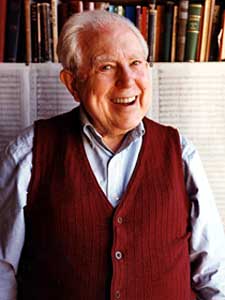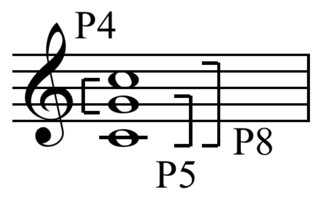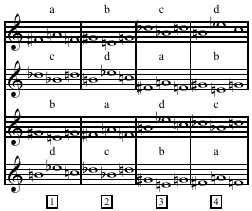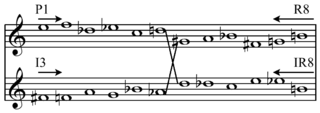In music, a tone row or note row, also series or set, is a non-repetitive ordering of a set of pitch-classes, typically of the twelve notes in musical set theory of the chromatic scale, though both larger and smaller sets are sometimes found.

The twelve-tone technique—also known as dodecaphony, twelve-tone serialism, and twelve-note composition—is a method of musical composition first devised by Austrian composer Josef Matthias Hauer, who published his "law of the twelve tones" in 1919. In 1923, Arnold Schoenberg (1874–1951) developed his own, better-known version of 12-tone technique, which became associated with the "Second Viennese School" composers, who were the primary users of the technique in the first decades of its existence. The technique is a means of ensuring that all 12 notes of the chromatic scale are sounded as often as one another in a piece of music while preventing the emphasis of any one note through the use of tone rows, orderings of the 12 pitch classes. All 12 notes are thus given more or less equal importance, and the music avoids being in a key. Over time, the technique increased greatly in popularity and eventually became widely influential on 20th-century composers. Many important composers who had originally not subscribed to or actively opposed the technique, such as Aaron Copland and Igor Stravinsky, eventually adopted it in their music.

Elliott Cook Carter Jr. was an American modernist composer. One of the most respected composers of the second half of the 20th century, he combined elements of European modernism and American "ultra-modernism" into a distinctive style with a personal harmonic and rhythmic language, after an early neoclassical phase. His compositions are known and performed throughout the world, and include orchestral, chamber music, solo instrumental, and vocal works. Carter was twice awarded the Pulitzer Prize.

Musical set theory provides concepts for categorizing musical objects and describing their relationships. Howard Hanson first elaborated many of the concepts for analyzing tonal music. Other theorists, such as Allen Forte, further developed the theory for analyzing atonal music, drawing on the twelve-tone theory of Milton Babbitt. The concepts of musical set theory are very general and can be applied to tonal and atonal styles in any equal temperament tuning system, and to some extent more generally than that.
In music theory, a trichord is a group of three different pitch classes found within a larger group. A trichord is a contiguous three-note set from a musical scale or a twelve-tone row.
The term "partition" is also French for the sheet music of a transcription.
In music using the twelve tone technique, combinatoriality is a quality shared by twelve-tone tone rows whereby each section of a row and a proportionate number of its transformations combine to form aggregates. Much as the pitches of an aggregate created by a tone row do not need to occur simultaneously, the pitches of a combinatorially created aggregate need not occur simultaneously. Arnold Schoenberg, creator of the twelve-tone technique, often combined P-0/I-5 to create "two aggregates, between the first hexachords of each, and the second hexachords of each, respectively."

In music theory, complement refers to either traditional interval complementation, or the aggregate complementation of twelve-tone and serialism.

A set in music theory, as in mathematics and general parlance, is a collection of objects. In musical contexts the term is traditionally applied most often to collections of pitches or pitch-classes, but theorists have extended its use to other types of musical entities, so that one may speak of sets of durations or timbres, for example.

In musical set theory, an interval vector is an array of natural numbers which summarize the intervals present in a set of pitch classes. Other names include: ic vector, PIC vector and APIC vector
An all-interval tetrachord is a tetrachord, a collection of four pitch classes, containing all six interval classes. There are only two possible all-interval tetrachords, when expressed in prime form. In set theory notation, these are [0,1,4,6] (4-Z15) and [0,1,3,7] (4-Z29). Their inversions are [0,2,5,6] (4-Z15b) and [0,4,6,7] (4-Z29b). The interval vector for all all-interval tetrachords is [1,1,1,1,1,1].

Composition for Four Instruments (1948) is an early serial music composition written by American composer Milton Babbitt. It is Babbitt’s first published ensemble work, following shortly after his Three Compositions for Piano (1947). In both these pieces, Babbitt expands upon the methods of twelve-tone composition developed by Arnold Schoenberg. He is notably innovative for his application of serial techniques to rhythm. Composition for Four Instruments is considered one of the early examples of “totally serialized” music. It is remarkable for a strong sense of integration and concentration on its particular premises—qualities that caused Elliott Carter, upon first hearing it in 1951, to persuade New Music Edition to publish it.

Neo-Riemannian theory is a loose collection of ideas present in the writings of music theorists such as David Lewin, Brian Hyer, Richard Cohn, and Henry Klumpenhouwer. What binds these ideas is a central commitment to relating harmonies directly to each other, without necessary reference to a tonic. Initially, those harmonies were major and minor triads; subsequently, neo-Riemannian theory was extended to standard dissonant sonorities as well. Harmonic proximity is characteristically gauged by efficiency of voice leading. Thus, C major and E minor triads are close by virtue of requiring only a single semitonal shift to move from one to the other. Motion between proximate harmonies is described by simple transformations. For example, motion between a C major and E minor triad, in either direction, is executed by an "L" transformation. Extended progressions of harmonies are characteristically displayed on a geometric plane, or map, which portrays the entire system of harmonic relations. Where consensus is lacking is on the question of what is most central to the theory: smooth voice leading, transformations, or the system of relations that is mapped by the geometries. The theory is often invoked when analyzing harmonic practices within the Late Romantic period characterized by a high degree of chromaticism, including work of Schubert, Liszt, Wagner and Bruckner.
Anton Webern's Concerto for Nine Instruments, Op. 24, Op. 24, written in 1934, is a twelve-tone concerto for nine instruments: flute, oboe, clarinet, horn, trumpet, trombone, violin, viola, and piano. It consists of three movements:

In musical set theory, a Forte number is the pair of numbers Allen Forte assigned to the prime form of each pitch class set of three or more members in The Structure of Atonal Music. The first number indicates the number of pitch classes in the pitch class set and the second number indicates the set's sequence in Forte's ordering of all pitch class sets containing that number of pitches.
In music, the "Ode-to-Napoleon" hexachord is the hexachord named after its use in the twelve-tone piece Ode to Napoleon Buonaparte (1942) by Arnold Schoenberg. Containing the pitch-classes 014589 it is given Forte number 6–20 in Allen Forte's taxonomic system. The primary form of the tone row used in the Ode allows the triads of G minor, E♭ minor, and B minor to easily appear.

In music, an all-interval twelve-tone row, series, or chord, is a twelve-tone tone row arranged so that it contains one instance of each interval within the octave, 1 through 11. A "twelve-note spatial set made up of the eleven intervals [between consecutive pitches]." There are 1,928 distinct all-interval twelve-tone rows. These sets may be ordered in time or in register. "Distinct" in this context means in transpositionally and rotationally normal form, and disregarding inversionally related forms.

In music theory, the chromatic hexachord is the hexachord consisting of a consecutive six-note segment of the chromatic scale. It is the first hexachord as ordered by Forte number, and its complement is the chromatic hexachord at the tritone. For example, zero through five and six through eleven. On C:
The Tone Clock, and its related compositional theory Tone-Clock Theory, is a post-tonal music composition technique, developed by composers Peter Schat and Jenny McLeod. Music written using tone-clock theory features a high economy of musical intervals within a generally chromatic musical language. This is because tone-clock theory encourages the composer to generate all their harmonic and melodic material from a limited number of intervallic configurations. Tone-clock theory is also concerned with the way that the three-note pitch-class sets can be shown to underlie larger sets, and considers these triads as a fundamental unit in the harmonic world of any piece. Because there are twelve possible triadic prime forms, Schat called them the 'hours', and imagined them arrayed in a clock face, with the smallest hour in the 1 o'clock position, and the largest hour in the 12 o'clock position. A notable feature of Tone-Clock Theory is 'tone-clock steering': transposing and/or inverting hours so that each note of the chromatic aggregate is generated once and once only.

 Play (help·info)).
Play (help·info)).
 Play (help·info))
Play (help·info))










